Abstract
This paper introduces the combination of Mind Genomics thinking with AI for the solution of practical issues, focusing specifically on what to do to create a viable Gaza after the hostilities cease. The approach allows the user to specify the problem, and the type of answers required. In seconds, the AI returns with actionable suggestions. The user can iterate, either using the same problem-specification, or changing the problem specification. After the user finishes the iterations and receives the initial results. The system returns within 30 minutes with a detailed summarization of each iteration. The summarization shows the key ideas, the reactions of audiences (acceptors vs rejectors), and ideas for innovative solutions. The approach is proposed as a way to think of new solutions, doing so at the level of the granular.
Introduction
The 1993 and 1995 Oslo Peace Accords between Palestinian and Israeli leaders negotiated for Israel’s withdrawal from Gaza and other key areas. This happened in 2005 under Prime Minister Ariel Sharon. An Islamist political group called Hamas won elections and took control of Gaza in 2006. Since then, Hamas has occupied the strip, which has become a site for protests, bombings, land assaults and other acts of violence. Israel and the United States, as well as several other countries, consider Hamas a terrorist organization [1].
The Hamas charter called for the abolition of Israel, and death to Israelis and Jews, world-wide. The Hamas charter did not have any proviso for co-existence, but rather called for a radical form of Islam. Hamas became the de facto government of Gaza, creating a massive military infrastructure. On October 7, 2023, during the Jewish holiday of Succoth, a Rave music festival was held in Israel, in areas abutting Gaza. An attack by Hamas terrorists ended up killing 1200 Israelis, and the abduction of more than, 200 many of whom were later killed. The Israeli response was justifiably furious, resulting in the wholesale destruction of Hamas, the destruction of the infrastructure of Gaza in a way resembling the destruction of Nazi Germany by the Allies. The academic literature is filled with the background to these issues, the public press filled with accusations, counter-accusations, and the brouhaha of seeming irreconcilable differences rooted in politics, education and Islam.
With the foregoing as a background, the question arose as what to do on the ‘day after,’ when Hamas would be declared ‘gone.’ What creative ideas about Gaza could emerge. The same problems occurred 80+ years ago upon the occasion of the Allied victory. What would happen the day after? Would the Allies follow the Morgenthau Plan of returning Germany to a more primitive country to punish it for the horrible crimes the Nazi’s had committed? Or would other plans for reconstruction be adopted, plans which guided Germany towards democracy, and towards a renewed place in ‘civil society.’ Fortunately for the world as well as for Germany, it was the latter plan that was adopted.
Using AI to Provide Suggestions about Rebuilding Gaza
The origins of this work come from at least three distinct sources. It is the combination of these sources which provides the specifics about what to do ‘the day after.’ These sources are Mind Genomics [2], then collaboration with Professor Peter Coleman at Columbia University [3], and finally the introduction of artificial intelligence into Mind Genomics and now the use of that AI technology to suggest ideas for rebuilding Gaza.
The first source is the emerging science of Mind Genomics [4]. Mind Genomics can best be thought of as an approach to understanding what the important factors are driving attitudes and decisions, the focus being the granular quotidian world, th world of the ordinary, the world of the everyday. Studies of decision making are the daily bread of those involved in consumer research, political polling, and so forth. Studies of decision making use a variety of techniques, such an observation, interpersonal discussions with individuals or groups, surveys, and even experiments creating artificial situations in which the pattern of behaviors gives an idea of what rules of decision making are being used. Within this framework, Mind Genomics provides a simple but powerful process, best described as presenting the respondent (survey taker) with systematically constructed combinations (vignettes), getting ratings of these vignettes, and then deconstructing the ratings into the contribution of the individual elements which constitute the building blocks the vignettes.
The second source is the recognition that quite often the research effort in Mind Genomics seems to be unduly difficult for the typical user. More often than not, a user investigating a topic may feel overwhelmed when asked to generate four questions about the topic, and then for each question, provide four answers. This is the way the science of Mind Genomics works. The problem is that ordinary people feel quite intimidated. It is the introduction of artificial intelligence a way to generate ideas (questions, answers to questions) which provides a way through the thicket, a way to do the study [5] The AI provided ere, SCAS, Socrates as a Service, becomes a tutor to the user, and in turn, a much appreciate feature of Mind Genomics.
The third source is the re-framing of the input to the AI. Rather than simply abiding by the request to provide simple questions and answers, the user can provide AI with a complete story, and ask the AI to provide appropriate answers. In most, although to be not in all the times, the change in focus ends up delighting, as the SCAS provides a far more integrated approach to solving a problem.
It is important to keep in mind that the approach presented here deals with suggestions about the practical solution of a problem, rather than with the more conventional academic approach of defining a narrow problem and seeking a testable solution.
Example – One of Many Iterations Dealing with the Reconstitution of Gaza
The remainder of this paper shows what SCAS, the artificial intelligence embedded in Mind Genomics, produces when properly queried. The process begins with the creation of a Mind Genomic study, as shown in Figure 1, Panel A. The creation of the study is templated, with Panel A showing that the user simply names the study, selects a language, and then agrees not to request nor accept private information.

Figure 1: Panel A – Project initiation. Panel B – Request for AI help (Idea Coach), or user-provided questions. Panel C – Rectangle where the user types the relevant information to prompt SCAS. Panel D – The rectangle filled with the relevant information.
Once the study has been created, the Mind Genomics program, www.bimileap, presents the user with a screen requesting four questions. It is at this point that the user can work with SCAS, the AI embedded in the program. Rather than providing four questions, the user presses the ‘Idea Coach’ button, and is led to a screen requesting that user type in the request. That screen appears in Figure 1, Panel C. Finally, the user provides background materials and the requests, as shown in Figure 1, Panel D.
Table 1 presents the full text version of the request that the user simply created and copied into the rectangle in Panel D. It is important to note that the language in Table 1 is simple, written in the way one might talk, filled with material which is both relevant (e.g., the phrase I want to find 14 different ways to do this. For each way, give the way a name and write that name in all titles. Then, in a paragraph tell me exactly what i should do) as well as personal and not particularly germane to the actual task (e.g., How do I do this as a private citizen who only can offer them Mind Genomics as a way to help business and education).
Table 1: The prompting information provided to SCAS (Socrates as a Service), the AI in Mind Genomics

Within a minute or so after the user presses the ‘submit’ button in Figure 1, Panel D, the embedded AI generates the first response. The first response is a set of 15 questions. These questions are assigned sequential numbers and are shown in Table 2. Afterwards, material such as that in Table 3 will appear.
Table 2: Results from immediately using SCAS to answer the 15 questions provided by SCAS as the ‘first answer’ to its request (see Table 2). Each question posed by SCAS in its initial response to the user is shown as a three-component paragraph (question posed, answer provided, SCAS-estimated performance of the answer). This step is a slight detour.
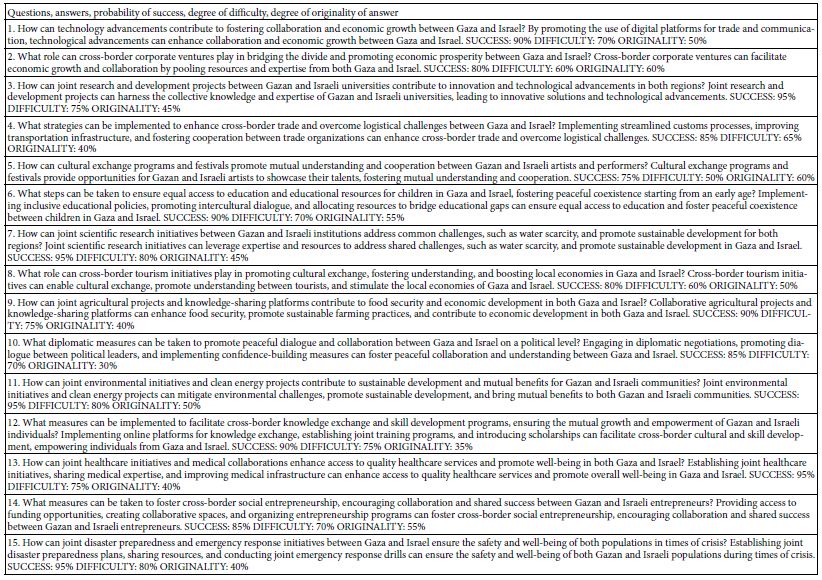
Table 3: The 14 efforts requested to SCAS in the squib, along with the elaboration of these efforts in simple-to-understand prose English.
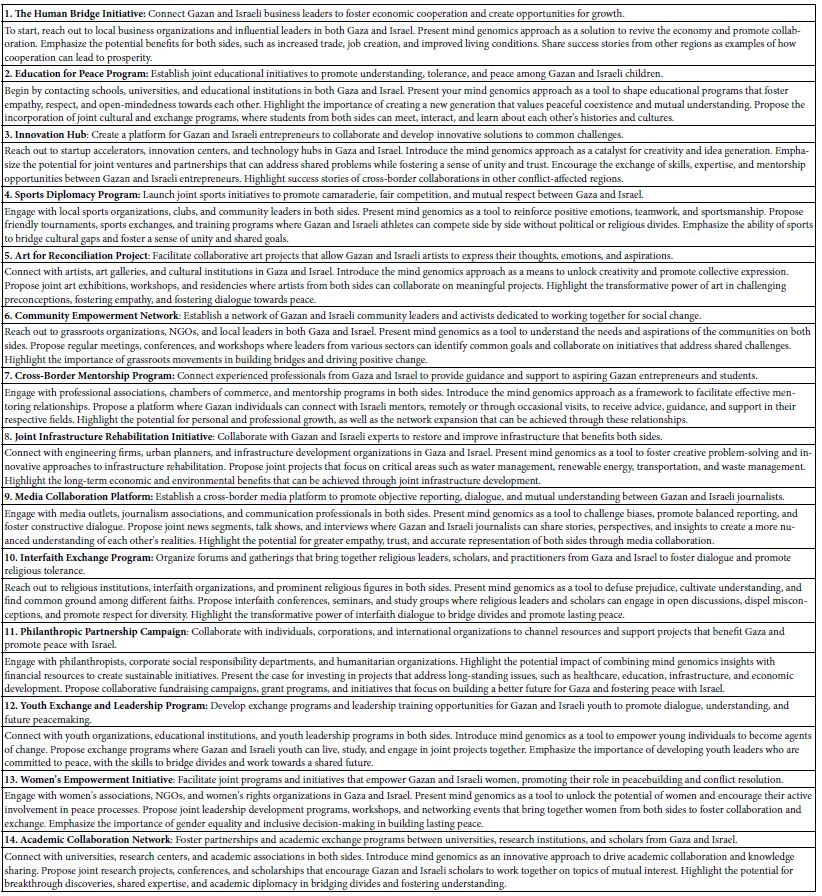
The Short, Momentary Detour, to Answer the Newly Presented Questions Which are Part of the Answer
Before proceeding, it is relevant to note an additional step that can be done, almost immediately. That step is to ask SCAS to ‘answer’ the 15 questions through an immediate next iteration. When the 15 questions appear, those shown in Table 2, SCAS has already done its work, responding to the request in Table 1. The program has also recorded all that needs to be recorded from the output of SCAS. The user is free now either to read all the information provided by AI, run another iteration, or take a quick detour to answer the 15 questions, before proceeding.
Table 2 shows what happens when the user copies the 15 questions, and then moves to the next iteration. The user presses requests permission to modify the input instructions to SCAS (Figure 1, Panel C). The user requests that SCAS repeat the question in text, then answer the question, and then rate the answer provided on three attributes, all on a 0–100-point scale. These three attributes are likelihood of success, degree of difficulty implementing the answer, and originality of the answer.
It is at Table 2 that one can see the power of the AI to help the user. It is not clear whether the user could have come up with these 15 questions, and certainly not in the time of 30 seconds. Should the user not like the questions, the user can continue to iterate until the user finds 15 questions of interest as outputs to the request made in Table 1. Once the set of questions are identified, it is straightforward to copy the set of questions, and mov in another direction by requesting SCAS to answer the 15 questions, and ‘scale the answer’ on the three dimensions. Finally, when that action, Table 2 is produced, the user now returns to the main study.
Once the first set of materials have been delivered, SCAS can be re-rerun for a second iteration. The user provided ‘squib’ or information about the topic and request to the AI, either remain the same, or can be edited ‘on the fly’ by the user. SCAS is now ready for a second run, and so forth. Iterations can be done in periods of about 30 seconds (excluding editing the squib to change the information to SCAS). Thus, the system becomes a tool for immediate iteration, learning, and fine tuning.
Once the user finishes the iterations and closes the study, either by working with respondents or simply by ‘logging off’, as was done here, the program puts each iteration into a separate Excel tab, and for that iteration performs a number of ‘summarizations’ explained and demonstrated below. Each iteration is analyzed thoroughly by its own ‘summarization,’ meaning that SCAS both generated the information from a minimal input shown in Table 1, and then created deep analyses of that information (Tables 2-6). For each study, the user receives the information in the ‘Idea Book,’ the aforementioned Excel book. For example, when the user decides to work with the program 15 times, iterating and then changing some of the squib, or even simply re-running the squib without changing it at all, the program will return within 30 minutes with the fully summarized material.
The remainder of this paper presents the results, discussing the nature of the results, the implications of the analyses presented, and so forth. It is important to keep in mind that for this particular study, it was possible to run the SCAS module more than 15 times, each iteration requiring less than 30 seconds, unless the squib was manually changed to shift direction in the effort to understand.
Ideas Presented – Answering the Statement ‘Mind Genomics for Business and Education
The initial request to SCAS was to provide 14 ideas for initiatives and programs, and then to explicate them. Again, the input information was minimal, focusing on business and education. Table 3 shows the results in detail, with the level of detail sufficient to ‘paint the picture’.
The summarization further proceeds with a variety of analyses about the ideas themselves. Table 4 shows three summarizations, as follows:
- Key ideas in the topic questions. As an aid to thinking, the summarization restates each of the questions in a simple manner.
- Further summarization occurs by distilling the ideas into general themes, and then for each theme showing the specific ideas relevant to that theme.
- Perspectives: For each theme, listing the positive and the negatives,
Table 4: Summarization of ideas into key questions, themes, and perspectives relevant to those themes
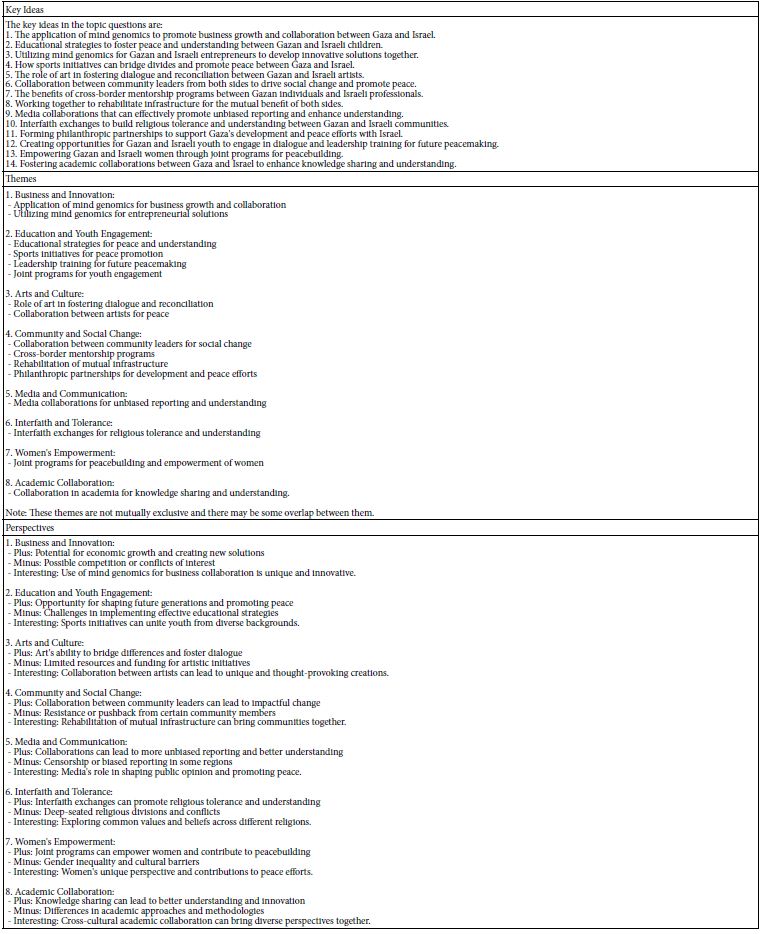
The expansion of the ideas continues, with the ‘summarizer’ considering which groups would be positive to the ideas (interested audiences) and which groups with be against the ideas (opposing audiences). Once again it is important to stress that these groups emerged from the AI further ‘working up’ the material that it generated before. Table 5 shows these two groups, interested audiences versus opposing audiences, emerging from this one iteration presented in depth in this paper.
Table 5: Responses to the suggestions, divided into interested audiences and opposing audiences
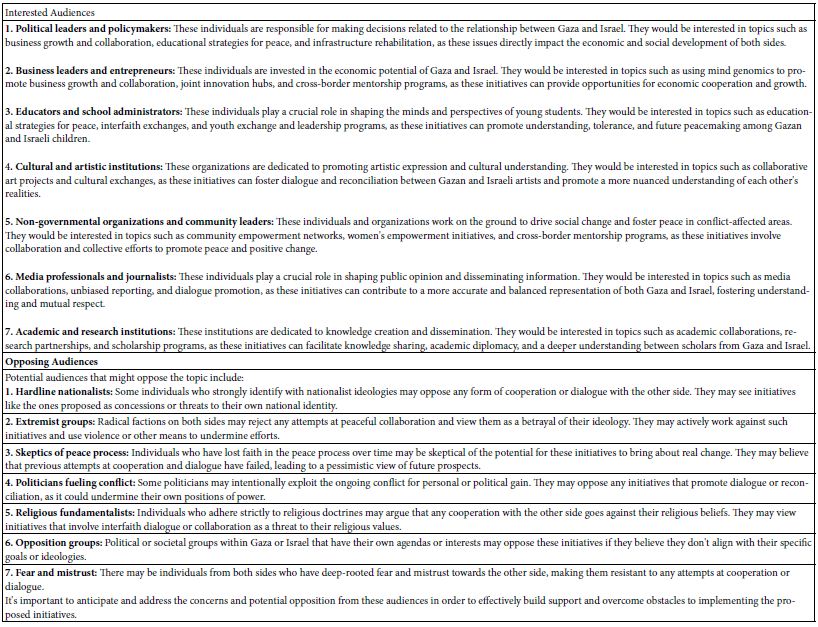
The final summarization presents the basis for new ideas, new strategies, and new products. Table 6 shows different ‘steps’ towards creating the ‘new’. The first comprises ‘alternative viewpoints,’ about the need for other perspectives. The second comprises ‘what is missing?’ focuses on additions to the 14 suggestions. The third comprises ‘innovations,’ first presenting the innovation and then providing some detail.
Table 6: Steps towards innovation; Alternative viewpoints, What is missing, and Innovations
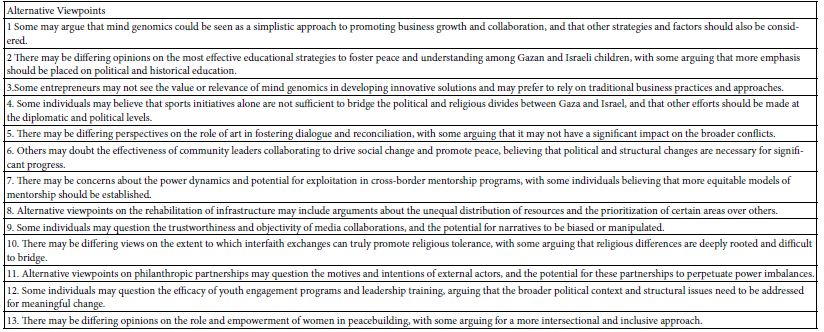
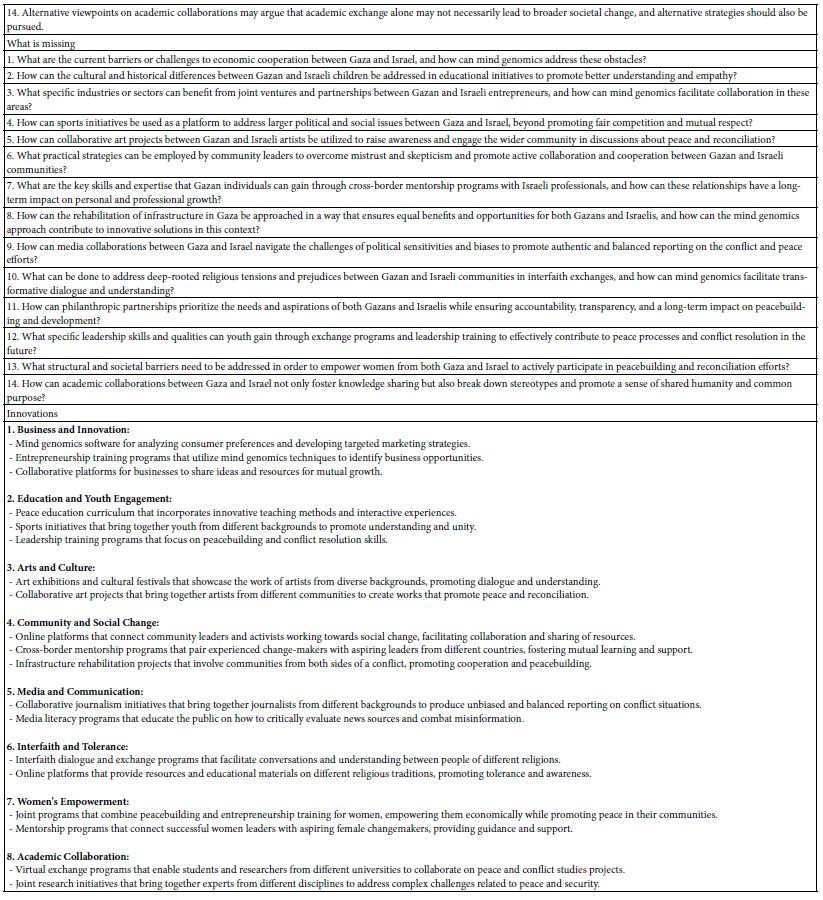
Discussion and Conclusions
As emphasized in the introduction to this paper, the focus here is to find so-called actionable solutions to the issue of what to do ‘the day after.’ There are many studies about the problems, their history, and their manifestations. The academic literature is replete with such analyses, and with suggested solutions, although the stark reality is that analysis often leads to its own implicit paralysis because the focus is on the ‘why,’ and not on the ‘what to do’.
The inspiration for the Mind Genomics work and its evolution presented here came from the world of consumer psychology, whose academic goal of ‘knowledge’ was deeply intertwined with the ultimate desire by some to improve business by understanding the mind of people. It was from that beginning and from the experience in medicine, and actually changing people’s behavior for the better [6] that the approach presented here evolved. The notion that SCAS (Socrates as a Service) could produce actionable results further motivated us, once it became apparent that one could challenge AI with issues, and have AI first provide solutions given minimal input, and then ‘work up’ those minimal solutions into far more profound results.
Finally, it is important to close with the realization that the information presented here required no more than a minute to create, or perhaps more correctly, nor more than 30 seconds to create. The important thing about that short time is that it permitted the user, whether researcher or policy maker, to explore many different alternatives with on-the-fly modifications of the input squib shown in Table 1. In effort after effort author HRM has discovered that one iteration did not suffice. Rather, natural curiosity promoted many iterations, almost in a way that could be called ‘results-addiction.’ The immediate information returning with 15 seconds, and then the receipt of the Idea Book by email within 30 minutes made the process almost irresistible, similar to consuming dessert for those who are so addicted to sweet things. Eventually the process stops, the Idea Book arrives, and the ideas contained therein take over, to be put into practice.
References
- https://www.history.com/news/gaza-conflict-history-israel-palestine (accessed February 13, 2024)
- Papajorgji P, Moskowitz H (2023) The ‘average person’ thinking about radicalization: A Mind Genomics cartography. Journal of Police and Criminal Psychology 38: 369-380. [crossref]
- Coleman PT (2021) The Way Out: How to Overcome Toxic Polarization. Columbia University Press.
- Moskowitz HR (2012) ‘Mind genomics’: The experimental, inductive science of the ordinary, and its application to aspects of food and feeding. Physiology & Behavior 107: 606-613. [crossref]
- Wu Y (2023) Integrating Generative AI in Education: How ChatGPT Brings Challenges for Future Learning and Teaching. Journal of Advanced Research in Education 2: 6-10.
- Nikolić E, Masnic J, Brandmajer T, Nikolic A (2022) Chronic pain control using Mind Genomics in patients with chronic obstructive pulmonary disease knowledge. International Journal 52: 455-459.